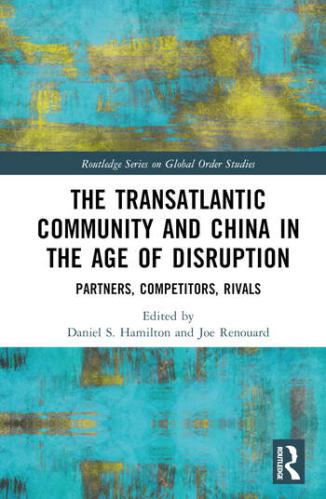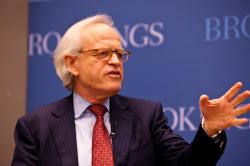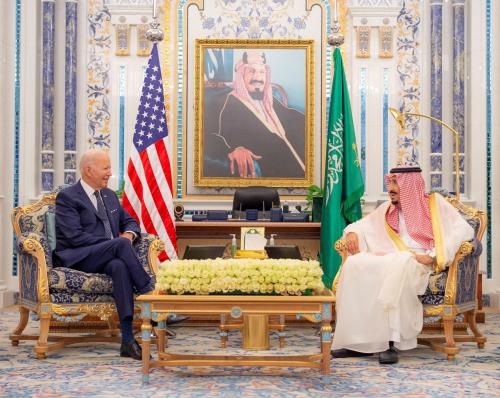On Tuesday, March 28, 2017, Martin Indyk testified before the Senate Foreign Relations Committee on “U.S. strategy toward Iran.” The following is adapted from that testimony, the full testimony is available here.
Iran is posing a comprehensive challenge to the interests of the United States and its allies and partners in the Middle East. Over the past four decades, it has managed to establish an “arc of influence” that stretches from Lebanon and Syria in the Levant, to Iraq and Bahrain on the Gulf, to Yemen on the Red Sea. What the United States now needs is a comprehensive, integrated, and sustainable “push-back” strategy.
Any such American strategy needs to take account of the way that, in the Middle East, everything is connected. Push back on Iran in Yemen, and they might well stir up the Shiite population in Bahrain. Push back on Iran in Syria, and they might well use the Shiite militias in Iraq to undermine our effort to eliminate ISIS there, or encourage Hamas to launch rocket attacks on Israel from Gaza.
A comprehensive strategy would need to contain at least six elements:
1Rigorous enforcement of the Iran nuclear deal. Whatever the perceived shortcomings of the JCPOA, it has succeeded in creating a vital 10-year window in which the region is not threatened by Iranian nuclear capabilities and the nuclear arms race that they would inevitably trigger. Nothing is easy about countering Iran in the conflict-ridden Middle East, but everything becomes easier if we do not have an Iranian nuclear threat to contend with at the same time. As long as the Iranians strictly adhere to the agreement, the United States and its regional allies will have gained vital time to develop and implement the other elements of the push-back strategy.
2Support for the Iraqi governmentof Haider al-Abadi and the Iraqi Armed Forces as they campaign to defeat ISIS and regain control of Mosul and the Sunni regions of Iraq. Eliminating Iran’s influence in Iraq is not an achievable or necessary objective given the historic and religious ties between the neighboring Shiites of Iraq and Iran. But providing an effective counter-balance to Iran’s influence in Baghdad is eminently achievable since it is welcomed by the current Iraqi government, which was not the case with the previous Maliki government.
While Saudi Arabia and the Gulf Arab states have long been unwilling to engage meaningfully with the Iraqi government, the recent visit of the Saudi Foreign Minister to Baghdad—and the Saudi effort to engage with the Sunni tribes of Iraq—presages a new approach which needs to be encouraged and sustained. The elimination of ISIS will generate a huge post-conflict reconstruction challenge in Mosul and the other liberated Sunni cities and towns. It will be particularly important to have Sunni state support for a major post-war reconstruction effort led by the Abadi government and reinforced by the United States. It is essential that Iranian-directed Shiite militias not be allowed to fill the vacuum and in the process establish a land bridge between Iran and Syria across northern Iraq.
3Promotion of a political resolution of the civil war in Yemen. The Trump administration is currently considering stepping up military support for Saudi Arabia and the UAE in their two-year long military campaign in Yemen. This makes sense only if it is wedded to a diplomatic strategy for ending the war, which has already caused thousands of civilian casualties and vast human suffering. Otherwise, the United States will be sucked into the Yemen quagmire like so many outside powers before us.
Gains on the battlefield should impact the dynamics at the negotiating table. In that regard, a successful effort to take control of the Red Sea port of Hodeida could impact the Houthi calculus and lead to greater seriousness and reasonableness on their part in the negotiations. But American support needs to be conditioned on the pursuit of a political solution by our Saudi allies as well.
4Reduce Iran’s influence in Syria. This will be difficult and complicated, and implementing it is not helped by loose talk about the unrealistic objective of “pushing Iran out of Syria.” We need to recognize that neither we, nor the Russians, have the will or capacity to achieve that goal—as desirable as it might be—in current circumstances.
Iran has developed a formidable presence on the ground in Syria: the Iranians have penetrated the remaining governing institutions of Asad’s regime, and have embedded some 30,000 forces in the government-controlled areas of western Syria (some 5,000 IRGC, Basij, and Iranian Army elements; some 3,000 to 5,000 highly trained Hezbollah fighters from Lebanon; and some 20,000 Shiite militiamen recruited from Afghanistan and Pakistan). These forces are significantly larger than what is left of the Syrian army or the Russian forces now deployed there.
The Iranian-controlled presence is bolstered by two key factors:
- The Iranian-Assad alliance,which was forged by Assad’s father in the 1980s. Since then, Assad’s son has become ever-more dependent on Tehran for his survival. Accordingly Assad will not dare demand Iran’s departure. Nor will Russia, since its primary interest is the survival of the regime.
- Iran’s “core interest” in retaining a foothold in Syria because it is the lynchpin of its wider hegemonic strategy. If it loses that foothold, it will seriously jeopardize Hezbollah’s control of Lebanon, the crown jewel of Iran’s regional strategy. That means Iran will mightily resist any effort to force it out of Syria and has considerable ability to do so.
Russia and Iran both seek to keep the Assad regime in power. But they are also rivals for influence in Damascus, and Assad relishes the opportunity to play them off against each other. Exploiting that rivalry has advantages for an American strategy of reducing Iranian influence in Syria. However, that game has strict upper limits. Russia will not cooperate in the undermining of its own influence in Syria for the sake of a partnership with the United States. The idea that Russia will force Iran out of Syria is therefore a dangerous fantasy. And the idea that we should pay for such a fantasy by removing the Ukraine sanctions on Russia would constitute strategic malfeasance, given the impact that would have on our allies in Europe, particularly in Eastern Europe.
We should therefore set more modest objectives. We should, for example, press Russia to deny Iran port facilities in Syria. An Iranian-controlled port would enable Iran more easily to ship weapons to Hezbollah, exacerbating the conflict between Iran and Israel—something Russia has an interest in avoiding. Similarly, we should support Israel’s insistence that Russia press Iran and Hezbollah not to send their forces south to the Golan Heights.
Finally, as in Yemen, we should do what we can to promote a political resolution of the Syrian civil war, one that leads eventually but inevitably to Assad’s departure. One requirement of the political settlement should be the departure of all foreign forces. That principle was incorporated into the Taif Agreement, which ended the Lebanese civil war and eventually resulted in the peaceful departure of Syrian forces from Lebanon. Syrians, who do not want Iranian-controlled Shiite militias dominating them in a post-conflict era, will welcome inclusion of that principle. And it will provide us with the legitimacy to demand their eventual departure.
5Concert the capabilities of our regional allies in a regional security framework that can sustain a long-term, burden-sharing effort. The United States is fortunate to have capable regional strategic partners in Israel, Turkey, Saudi Arabia, and the Sunni Arab states that share a common interest in countering Iran’s threatening ambitions. While each has its own strategic perspective, there is a new readiness across the region to work together, with Turkey, the Gulf states, and Egypt all improving cooperation with Israel, for example. It is time to test the readiness of our allies to come together in a regional security arrangement that will allow us all more effectively to coordinate our efforts against Iran.
6Lay the foundations for negotiations with Iran about its ambitions and behavior in the region. The Iran nuclear deal demonstrates that it is possible to reach enforceable agreements with Iran, using sanctions and concerted diplomacy as leverage to achieve our objectives. A newly-proposed U.S. sanctions bill—complemented by the effective implementation of the five other elements of the push-back strategy—provides a basis for engaging Iran in a negotiation that focuses on:
- Iran’s efforts to export its revolution and interfere in the domestic affairs of Arab states across the region;
- Iran’s destabilizing regional activities and its sponsorship of terrorism; and
- Iran’s intercontinental ballistic missile program and its nuclear activities after the expiration of the Joint Comprehensive Plan of Action (JCPOA).
Negotiations are not a concession to Iran, nor a sign of weakness, as long as they are backed by sanctions and the other elements of the strategy, and as long as they are fully coordinated with our regional allies. But they represent a way to signal to Iran that the United States and its regional allies are willing to have a constructive, normalized relationship with it, even to recognize its status as a regional power, if it is willing to change its troubling behavior in fundamental ways. Indeed, if the Iranians prove willing to engage in a serious negotiation about these issues, we should also be prepared to signal a willingness to lift all our bilateral sanctions—i.e. putting a carrot as well as a stick on the table.
Countering Iran’s regional hegemonic ambitions is a deadly serious business. In pursuing this objective, we should be careful about making threats unless we are prepared to back them up, and we should be wary of declaring objectives that we have neither the will nor interest to achieve. Above all, we should be mindful of the logical consequences of our strategy and think those through before launching on a course that could well have the opposite effect of what we intended. None of those cautions, however, should deter the United States from taking up the challenge while we have the opportunity to do so.







Commentary
6 elements of a strategy to push back on Iran’s hegemonic ambitions
March 29, 2017